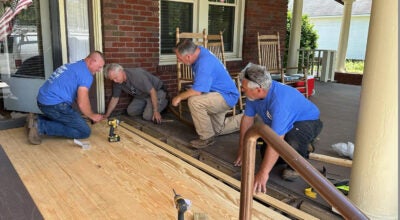Shipwrecked Concordia wrested off Italian reef
Published 12:00 am Monday, September 16, 2013
GIGLIO ISLAND, Italy (AP) — In an unprecedented maritime salvage operation, engineers on Monday gingerly wrestled the hull of the shipwrecked Costa Concordia off the Italian reef where the cruise ship has been stuck since January 2012.
Yet progress was much slower than predicted and the delicate operation to rotate the luxury liner from its capsized position to upright appeared likely to stretch into Tuesday, a senior official said.
Never before has such an enormous cruise ship been righted, and the crippled Concordia didn’t budge for the first three hours after the operation began, engineer Sergio Girotto told reporters.
But after some 6,000 tons of force were applied — using a complex system of pulleys and counterweights — Girotto said “we saw the detachment” from the reef thanks to undersea cameras.
He said the cameras did not immediately reveal any sign of the two bodies that were never recovered from among the 32 people who died Jan. 13, 2012, when the Concordia slammed into a reef and toppled half-submerged on its side after coming too close to Giglio Island.
Images transmitted Monday by robotic diving vehicles indicated that the submerged side of the cruise ship’s hull had suffered “great deformation” from all its time on the granite seabed, battered by waves and compressed under the weight of the ship’s 115,000 tons, Girotto said.
The initial operation to lift the Concordia from the reef moved the ship just 3 degrees toward vertical, leaving the vessel some 62 degrees shy of being pulled upright. While a seemingly small shift, the movement was significant enough to be visible: A few feet of slime-covered ship that had been underwater slowly became visible above the waterline.
The entire rotation was originally expected to last as long as 12 hours. But as evening approached, work was clearly falling behind schedule. Some seven hours after the rotation attempt began, the Concordia had moved upward only by a total of 10 degrees.
“It’s taking longer than expected,” Girotto said in a late afternoon briefing. “Even if it’s 15 to 18 hours, we’re OK with that. We are happy with the way things are going.”
Officials stressed that so far no appreciable pollution from inside the ship had spewed out. Giglio is part of a Tuscan archipelago in a marine sanctuary where dolphins and fish are plentiful.
The operation, known in nautical parlance as parbuckling, was used on the USS Oklahoma in 1943 after the Japanese attack on Pearl Harbor. But the 300-meter (1,000-foot) Concordia has been described as the largest cruise ship ever to capsize and subsequently require the complex rotation.
Engineers used remote controls to guide a synchronized system of pulleys, counterweights and huge chains that were looped under the Concordia’s carcass to delicately nudge the ship free from its rocky seabed.
Later in the rotation process, a series of tanks fixed on the exposed side of the hull will be filled with water to help pull it down. That phase of the process should rotate the ship faster than the initial phase of winching, said Costa Crociere’s project manager, Franco Porcellacchia.
Once the ship is upright, engineers hope to attach an equal number of tanks filled with water on the other side to balance the ship, anchor it and stabilize it during the winter months. The flat-keeled hull itself will be resting on a false seabed some 30 meters (100 feet) underwater.
When it comes time to tow the ship next spring, the tanks will gradually be emptied of the water. That will make the ship buoyant enough to float off the seabed like a pair of giant water wings.
A few dozen island residents gathered Monday on a breakwater to witness the operation. One woman walking her dog near the harbor sported a T-shirt with “Keep Calm and Watch the Parbuckling Project” written across it in English.
Engineers have dismissed as “remote” the possibility that the Concordia might break apart and no longer be sound enough to be towed to the mainland to be turned into scrap. Should the Concordia break apart during the rotation, or spew out toxic materials, absorbent barriers were set in place to catch any leaks.
The reef sliced a 230-foot gash into what is now the exposed side off the hull, letting seawater rush in. The resulting tilt was so drastic that many lifeboats couldn’t be launched. Dozens of the 4,200 passengers and crew were plucked to safety by helicopters or jumped into the sea and swam to shore. Bodies of many of the dead were retrieved inside the ship, although two bodies were never found.
The Concordia’s captain is on trial on the mainland for alleged manslaughter, causing a shipwreck and abandoning the ship during the chaotic and delayed evacuation. Capt. Francesco Schettino claims the reef wasn’t on the nautical charts for the liner’s weeklong Mediterranean cruise.
Parbuckling was supposed to begin before dawn, but the operation was pushed back by an overnight storm that delayed the positioning of the barge that serves as the command control center. After the storm blew away, seas were calm and the weather was sunny.
Costa Crociere SpA, the Italian unit of Miami-based Carnival Corp., is picking up the tab for the parbuckling and its intricate preparation. The company puts the costs so far at 600 million euros ($800 million), though much of that will be passed onto its insurers.
Despite the disaster, locals have come to appreciate the crews who have spent more than a year working on the wreckage, renting out hotel rooms and vacation apartments that would otherwise have gone vacant during the winter.
Giovanni Andolfi, a 63-year-old resident who spent his career at sea, called the crews “the best brains in the field.” But he was eager to see them finish.
“I would like Giglio to return to what it was before, a beautiful place of uncontaminated nature,” he said.




